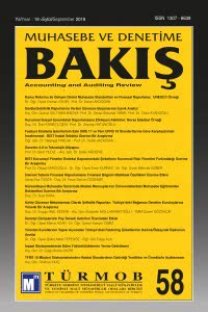Altın piyasasında ay ve mevsim etkisinin incelenmesi: Türkiye uygulaması
Altın; finansal ve ekonomik krizlere karşı yatırımcının güvenli limanı olurken, portföy tercihlerinde toplam riski dağıtmak amacıyla tercih edilebilen önemli bir finansal araçtır. Aynı zamanda altın, mücevher amacıyla da kul- lanılan kıymetli bir madendir. Bu çalışmada Türkiyedeki altın fiyatlarında meydana gelen değişimler ay ve mevsimlerin dikkate alınması ile incelenmiştir. Elde edilen bulgular doğrultusunda altın fiyatlarında ay ve mevsimlere bağlı herhangi bir anomalinin söz konusu olup - olmadığı incelenmiştir. Çalışmada, 1977:12-2012:06 dönemi arasındaki 414 aylık altın getiri verisinden faydalanılarak, regresyon analizi uygulanmıştır. Elde edilen bulgular altının dönem olarak ay alındığında, Ocak ve Eylül aylarında pozitif ve istatistiksel olarak anlamlı getiri sunduğunu göstermiştir. Dönem olarak mevsim alındığında ise, Sonbahar ve Kış mevsimlerinde pozitif ve istatistiksel olarak anlamlı altın getirisinin söz konusu olduğu belirlenmiştir.
The anal ysıs of month and season effects on the gold market: The case of Turkey
While gold is investors' safe haven for financial and economic crises, it is an important financial tool that can be chosen in order to distribute the total risk of portfolio preferences. At the same time, gold is a precious me- tal which is used as jewelry. In this study, the changes in gold prices in Turkey is examined according to the months and the seasons. According to findings, it is examined if there is any anomaly which is depended on months and seasons. In the study, regression analysis was applied with 414 monthly gold returns data between 1977:12-2012:06 periods. The findings show that gold returns on the January and September months are posi- tive and statistically significiant. At the same time, the gold returns on the autumn and winter seasons are posi- tive and statistically significiant.
___
ATAKAN, Tülin, İstanbul Menkul Kıymetler Borsasında Haftanın Günü Etkisi ve Ocak Ayı AnomalilerininARCH-GARCH Modelleri ile Test Edilmesi, İstanbul Üniversitesi İşletme Fakültesi Dergisi, Cilt 37, Sayı 2, 2008, ss. 98-1 10.
BALL, Clifford A., Walter N. Torous ve Adrian E. Tschoegl, Gold and the Weekend Effect, Journal of Futu-res Markets 2, 1982, ss.175-182.
BAUR, Dirk G. ve Thomas K. McDermott, Is Gold a Safe Haven? International Evidence, Journal of Banking and Finance, 34 (8), 2010, ss.18861898.
BAUR, Dirk, The Autumn Effect of Gold, Research in International Business and Finance, 27 (1), 2013, ss. 1-1 1, Kabul tarihi:2012.
BLOSE, Laurence E. ve Vijay Gondhalekar, Weekend Gold Returns, 2012 Midwest Dsi Annual Conference Grand Rapids, Michigan, Conference Theme: Sustainability, Innovation And Global Supply Chain Management, 2012.
CAPIE, Forrest, Terence C. Mills ve Geoffrey Wood, Gold as a Hedge Against The Dollar, Journal of Inter- national Financial Markets, Institutions and Money, 15 (4), 2005, ss. 343352.
COUTTS, J. Andrew, ve Mohamed A. Sheikh, The Anomalies That Arent There: The Weekend, January and Pre-holiday Effects On The All Gold Index On The Johannesburg Stock Exchange 19871997, Applied Financial Economics, 12, 2002, ss. 863-871.
ÇİNKO, Murat, İstanbul Menkul Kıymetler Borsasında Ocak Ayı Etkisi, Doğuş Üniversitesi Dergisi, Cilt 9, Sayı 1, 2008, ss. 47-54.
KAMSTRA, Mark J., Lisa A. Kramer ve Maurice D. Levi, Winter Blues: A SAD Stock Market Cycle, American Economic Review, 93 (1), 2003, ss. 324343.
KARAN, Mehmet Baha ve Uygur Akyay, İstanbul Menkul Kıymetler Borsasında Haftanın Günleri ve Ocak Ayı Etkilerinin Firma Büyüklüğü Açısından Değerlendirilmesi, Ankara Üniversitesi Siyasal Bilgiler Fakültesi Dergisi, Sayı 56, 2001, ss.103-116.
KÜÇÜKSİLLE, Engin, İMKB Endekslerinde Ocak Ayı Etkisinin Test Edilmesi, Muhasebe ve Finansman Dergisi, Ocak 2012, ss. 129-138.
LE, Thai-Ha ve Youngho Chang, Dynamic Relationships Between The Price of Oil, Gold and Financial Variab-les in Japan: A Bounds Testing Approach, http://mpra.ub.uni-muenchen.de/33030/.2011, 04.03.2012.
MA, Christopher. K., A Further Investigation of the Day-of-the-Week Effect in the Gold Market, Journal of Futures Markets,6, 1986, ss.409-419.
MANSOR, Ibrahim H., Fınancıal Market Risk And Gold Investment in an Emerging Market: The Case of Malaysia, Romanian Journal of Economic Forecasting, 2011, ss.79-89.
POYRAZ, Erkan ve Saliha, Didin, Altın Fiyatlarındaki Değişimin Döviz Kuru, Döviz Rezervi ve Petrol Fiyatlarından Etkilenme Derecelerinin Çoklu Faktör Modeli İle Değerlendirilmesi, Süleyman Demirel Üniversitesi İktisadi ve İdari Bilimler Fakültesi Dergisi , 13 (2),, 2008, ss.93-104.
SMITH, Graham, London Gold Prices and Stock Price Indices in Europe and Japan, http://www.gold.org/download/get/value/stats/research/pdf/GOLDandEUJPStockIndicesFeb2002.pdf, 25.01.2012.
TOPÇU, Ayhan, Altın Fiyatlarını Etkileyen Faktörler,SPK Araştırma Raporu, Ankara,2010.
TORAMAN, Cengiz, Çağatay Başarır ve Mehmet F. Bayramoğlu, Determination of Factors Affecting the Price of Gold: A Study of MGARCH Model, Business and Economics Research Journal, 2 (4), 2011, ss. 37-50.
VURAL, M.Göknil, Altın Piyasası ve Altın Fiyatlarını Etkileyen Faktörler, TCMB Uzmanlık Yeterlilik Tezi, Ankara, 2003.
- ISSN: 1307-6639
- Yayın Aralığı: Yılda 3 Sayı
- Başlangıç: 2000
- Yayıncı: TÜRMOB
Sayıdaki Diğer Makaleler
ALTIN PİYASASINDA AY VE MEVSİM ETKİSİNİN İNCELENMESİ: TÜRKİYE UYGULAMASI
Reşat KARCIOĞLU, Enis Baha BİÇER
Risk odaklı iç denetim uygulamalarında yabancı ortaklığın etkisi: İMKB uygulaması
RİSK ODAKLI İÇ DENETİM UYGULAMALARINDA YABANCI ORTAKLIĞIN ETKİSİ: İMKB UYGULAMASI
Altın piyasasında ay ve mevsim etkisinin incelenmesi: Türkiye uygulaması
